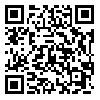Volume 2, Issue 3 (8-2020)
alkhass 2020, 2(3): 13-18 |
Back to browse issues page
Download citation:
BibTeX | RIS | EndNote | Medlars | ProCite | Reference Manager | RefWorks
Send citation to:



BibTeX | RIS | EndNote | Medlars | ProCite | Reference Manager | RefWorks
Send citation to:
Hosseini S B, Baghbanian M, Shafaie R. Determining the relationship between ethical environment climate and tending to desertion in the small and medium industries. alkhass 2020; 2 (3) :13-18
URL: http://alkhass.srpub.org/article-4-59-en.html
URL: http://alkhass.srpub.org/article-4-59-en.html
Master of Business Administration student at Azad University , Sanandaj,Iran;
Abstract: (3253 Views)
This study aims to survey the relationship between ethical environment and tending to be desertion in the small and medium industries of the Sanandaj city (Chemical industry cluster). For this purpose, all the employees of these companies were examined in terms of population and 310 of them were chosen according to Morgan Table. The research method id descriptive and correlational. This study is practical in terms of purpose and survey in terms of method of data collection. Accordingly, Babinet.al standard inventory to assess ethical climate and Dickonik and Stillwell’sinventory were used to assess tending to desertion. The reliability of the questionnairewas calculated in terms of Cronbach's alpha for the variables listed as 0.885 and 0.893, respectively. For inventory’s validity, content validity and with the opinions of advisors and some professors were confirmed.The final results of the study in SPSS software showed a significant inverse relationship between ethical climate and a desire to desertion in the company under investigation..
Type of Study: Research |
Subject:
Environmental Science (General)
Received: 2020/05/22 | Revised: 2020/07/14 | Accepted: 2020/07/25 | Published: 2020/08/1
Received: 2020/05/22 | Revised: 2020/07/14 | Accepted: 2020/07/25 | Published: 2020/08/1
References
1. Clebbeek, A. C., &Bax, E. H. (2004). Is high employee real harmful? An empirical test using compact records. Academy Journal of Management, 47, 277-286.
https://doi.org/10.5465/20159578 [DOI:10.2307/20159578]
2. Hom P.W, Griffeth, R.W. (١٩٩5). Structural equations modeling test of a turnover theory: cross- sectional and longitudinal analyses. J ApplPsychol; ٧٦:٣٥٠- ٦٦ (June).
3. Elci, M. and Alpkan, L. (2009). The impact of perceived organizational ethical climate on work satisfaction. Journal of Business Ethics. 84: 297-311. [DOI:10.1007/s10551-008-9709-0]
4. Okpara, O., Wynn, J. (2008). The impact Ethical climate on job satisfaction, and commitment in Nigeria. Journal of Management Development. 9. 54-63. [DOI:10.1108/02621710810901282]
5. Koh, H. C. & Boo, E. H. (2001).The link between organizational ethical and job satisfaction; Journal of Business Ethics.29, 309-324. [DOI:10.1023/A:1010741519818]
6. Mulki JP, JF, Locander, WB. (2006). Effects of ethical climate and supervisory trust on salesperson's job attitudes and intentions to quit. J Pers Sell Sales Manage 2006; 26:119-32. [DOI:10.2753/PSS0885-3134260102]
7. Jaramillo, F., Mulki, J., Soloman, p. (2006). The role of ethical on salesperson role stress, gob attitudes, turnover intenion, and job performance, The Journal of Personal Selling Management. 26(3).44-62 [DOI:10.2753/PSS0885-3134260302]
8. Deconinck, James B. (2011), " The influence of ethical climate on marketing employees job attitudes and behavior ", Journal of Business Research, No.63, PP:384-391 [DOI:10.1016/j.jbusres.2008.11.009]
9. Victor, B. Cullen, B. (1988). A theory and measure of ethical climate in organizations. Administrative Science Quarterly. 33, 101-125. [DOI:10.2307/2392857]
10. Parker PP, Baltes BB, Young SA, Huff JW, Altmann RA, Lacost HA,(2003), Relationships between psychological climate perceptionsand work outcomes: a meta-analytic review. J Organ Behav:389-416. [DOI:10.1002/job.198]
11. Cullen, J., B., B.Victor&C.Stephens (1989). " An ethical weather report: Assessing the organizations ethical climate" , Organizational Dynamics, No, 18, PP:50-63. [DOI:10.1016/0090-2616(89)90042-9]
12. Martin, Graeme. Phillip Beaumont. Rosalind doig, Judy Pate. (2005). A New Performance Discourse for HR? European Management Journal, Vol. 23, No. 1, p. 76-88. [DOI:10.1016/j.emj.2004.12.011]
13. Senge, Peter (2005), five commands to create a learning organization, translated by Hafiz Kamal Hedayat, published by Industrial Management Institute, Tehran.
14. Saadat, Esfandyar. (1986), human resource management, SAMT publication, 1st edition, Tehran.
15. Zeeman, Sergio (2006), advertising as we knowreached the end, translated byManizheh Sheikh Javadi, Tehran: Siteh Publication.
16. Miller, John Moore, David (2006), trade namesbusiness, translated by AtiehBathaie, Rasa Publications.
17. Tett, R.P & Meyer, J.P. (1993). " Job satisfaction ,organizational commitment, turnover intention, and turnover: Path analyses based on meta-analytic findings". Personnel Psychology, 46, 259-293. [DOI:10.1111/j.1744-6570.1993.tb00874.x]
18. Handlon, R.S. (2009). The departure of the insurance agent: The impact organizational commitment, organizational justic, and job satisfaction have on intent to leave in the insurance industry, August.
19. Khuong, M, N. and Tien, B, D. (2013). Factors influencing employee loyalty directly and indirectly through job satisfaction - A study of banking sector in Ho Chi Minh City, International Journal of Current Research AndAcacemic Review, Volume 1 Number 4, pp. 81-95.
20. Caboli, Maliha and Sanei, Mehdi. (2014), the factors affecting the desertion or continuingof judiciary staffs' services at Semnan Province, the Master's thesis, Islamic Azad University, Shahrood Branch, Department of Human Sciences.
21. Babin, BJ, Boles JS, Robin D.P. (2000). Representing the perceivedethical work climate among marketing employees. J Acad MarkSci; 28(3):345-58 [DOI:10.1177/0092070300283004]
22. Deconinck, J, Stilwell, D. (2004). Incorporating organizational justice, role states, pay satisfaction and supervisor satisfaction in a model of turnover intentions. J Bus Res 2004; 57:225-31. [DOI:10.1016/S0148-2963(02)00289-8]
Send email to the article author
| Rights and permissions | |
 |
This work is licensed under a Creative Commons Attribution-NonCommercial 4.0 International License. |









